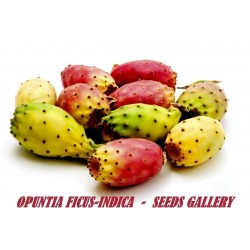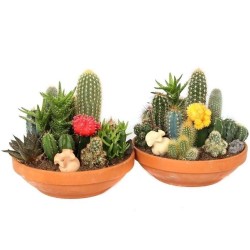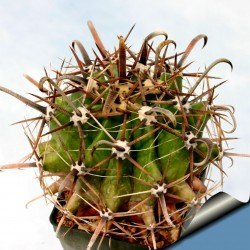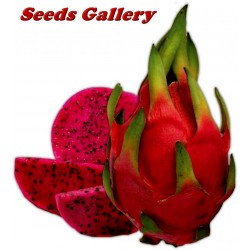
Chumbo Semințe (Opuntia...
Pret
2,25 €
SKU: CT 1
Seeds Gallery Com,
5/
5
<!DOCTYPE html>
<html>
<head>
<meta http-equiv="Content-Type" content="text/html; charset=UTF-8" />
</head>
<body>
<h2><strong>Chumbo Semințe (Opuntia Ficus-Indica)</strong></h2>
<h2><span style="color: #ff0000;"><strong>Preț pentru pachetul de 25+- (0,5g) semințe.</strong></span></h2>
<p><b>Opuntia ficus-indica</b><span> </span>sau<span> </span><b>chumbo</b><span> </span>aparține genului<span> </span>Opuntia, familia<span> </span>Cactaceae. Planta este originară din<span> </span>Mexic<span> </span>unde este cunoscută și folosită dinaintea descoperirii<span> </span>Americii. Fructul opuntiei poartă numele de chumbo (sau fruct de cactus, smochină chumbo) și este acoperit de o coajă groasă,spinoasă cu pulpa bogată în semințe,are o formă ovală și măsoară de la 5-11cm și are un diametru de 5,5-7cm. În alte limbi fructul poartă numele de: higo chumbo în<span> </span>spaniolă, fico d'India în<span> </span>italiană, Figuier de Barbarie în<span> </span>franceză.</p>
<p>În<span> </span>Mexic<span> </span>se folosește atât fructul ca atare cât și bucățile tinere ale întregii plante care se întrebuințează în bucătărie. În<span> </span>Maroc<span> </span>unde este foarte cultivat cactusul se folosește ca furaj, iar fructul în alimentația umană.</p>
<p>Cactusul este cultivat în mari zone ale lumii precum: zona mediteraneană (Spania,<span> </span>Italia,<span> </span>Algeria,<span> </span>Israel), zone din Orientul Mijlociu și cornul Africii (Etiopia,<span> </span>Eritreea),<span> </span>Mexic<span> </span>și sudul Americii de Sud (Chile,<span> </span>Argentina).</p>
<h2><span class="mw-headline" id="Recoltare">Recoltare</span></h2>
<p>Recoltarea și pregătirea fructului chumbo pentru consum are o tehnică specifică pentru înlăturarea spinilor.La recoltare se folosesc mănuși groase, cuțite și este bine ca și fața să fie protejată deoarece spinii luați de vânt pot fi periculoși. Apoi,fructele se lasă pe pământ și cu o perie se îndepărtează spinii. Odată ajunși acasă se pun fructele sub jetul de apă pentru a ne asigura că s-au curățat bine de spini.</p>
<h2><span class="mw-headline" id="Consum">Consum</span></h2>
<p>Fructul chumbo este savuros și dulce. Fructul se poate mânca proaspăt iar dacă se taie în felii și se acoperă cu zahăr se obține un sirop care se poate consuma rece sau se poate amesteca cu alte fructe. Din fructul opuntiei se mai poate face gem,suc natural sau se poate usca și consuma așa. În unele zone centrale ale<span> </span>Siciliei<span> </span>din acest fruct se obține o băutură numită<span> </span><i>Ficodi</i><span> </span>care se folosește atât ca aperitiv cât și ca medicament.</p>
<p>În unele bucătării tradiționale se folosește sărat și se adaugă sosurilor pentru carne și salate.</p>
<p>Mai poate fi folosit în industria cosmetică.</p>
<h2><span id="Compozi.C8.9Bie"></span><span class="mw-headline" id="Compoziție">Compoziție</span></h2>
<p>Bucățile fragede de opuntia ficus-indica conține 90%apă. Fructul conține 12%zahăr, 6,75% materii nitrogenate și 0,1% acizi organici care dau culoarea galben-portocalie fructelor și care trece în urina celor ce o consumă colorând-o în această culoare.</p>
<h2><span id="Produc.C8.9Bie"></span><span class="mw-headline" id="Producție">Producție</span></h2>
<p>Mexicul este principalul cultivator mondial al acestui cactus. Pământul cel mai recomandat sădirii cactusului este cel sărac în apă și de slabă calitate.</p>
<p><span style="color: #008000;"><strong>Growing Information:</strong> This species can tolerate much colder conditions than most cacti. It is considered hardy to at least zone 9. Flowering from June through September, the flowers are hermaphrodite, relying on insects for pollination. This species requires a well-drained, preferably sandy soil with a relatively neutral PH. A commercial cactus potting soil will work well. Seeds can be sown directly outdoors in a garden bed or started in pots and transplanted outdoors. The fruit contains germination inhibitors, so soaking the seeds and changing the water regularly may be beneficial. Prior to your soak, rub them on some sandpaper so the water can penetrate the seed coat. so your seeds will produce a cross if you allow it to flower with other species of opuntia. The pads can be pulled off your plants and rooted simply by burying them halfway in the soil.</span></p>
<table style="width: 500px;" cellspacing="0" cellpadding="0" border="1">
<tbody>
<tr>
<td colspan="2" width="100%" valign="top">
<p align="center"><span style="color: #008000;"><strong>Sowing Instructions</strong></span></p>
</td>
</tr>
<tr>
<td valign="top" nowrap="nowrap">
<p align="center"><span style="color: #008000;"><strong>Propagation:</strong></span></p>
</td>
<td valign="top">
<p align="center"><span style="color: #008000;">Seeds</span></p>
</td>
</tr>
<tr>
<td valign="top" nowrap="nowrap">
<p align="center"><span style="color: #008000;"><strong>Pretreat:</strong></span></p>
</td>
<td valign="top">
<p align="center"><span style="color: #008000;">0</span></p>
</td>
</tr>
<tr>
<td valign="top" nowrap="nowrap">
<p align="center"><span style="color: #008000;"><strong>Stratification:</strong></span></p>
</td>
<td valign="top">
<p align="center"><span style="color: #008000;">0</span></p>
</td>
</tr>
<tr>
<td valign="top" nowrap="nowrap">
<p align="center"><span style="color: #008000;"><strong>Sowing Time:</strong></span></p>
</td>
<td valign="top">
<p align="center"><span style="color: #008000;">all year round</span></p>
</td>
</tr>
<tr>
<td valign="top" nowrap="nowrap">
<p align="center"><span style="color: #008000;"><strong>Sowing Depth:</strong></span></p>
</td>
<td valign="top">
<p align="center"><span style="color: #008000;">Needs Light to germinate! Just sprinkle on the surface of the substrate + gently press</span></p>
</td>
</tr>
<tr>
<td valign="top" nowrap="nowrap">
<p align="center"><span style="color: #008000;"><strong>Sowing Mix:</strong></span></p>
</td>
<td valign="top">
<p align="center"><span style="color: #008000;">Coir or sowing mix + sand or perlite</span></p>
</td>
</tr>
<tr>
<td valign="top" nowrap="nowrap">
<p align="center"><span style="color: #008000;"><strong>Germination temperature:</strong></span></p>
</td>
<td valign="top">
<p align="center"><span style="color: #008000;">20-25°C</span></p>
</td>
</tr>
<tr>
<td valign="top" nowrap="nowrap">
<p align="center"><span style="color: #008000;"><strong>Location:</strong></span></p>
</td>
<td valign="top">
<p align="center"><span style="color: #008000;">bright + keep constantly moist not wet</span></p>
</td>
</tr>
<tr>
<td valign="top" nowrap="nowrap">
<p align="center"><span style="color: #008000;"><strong>Germination Time:</strong></span></p>
</td>
<td valign="top">
<p align="center"><span style="color: #008000;">1 - 8 weeks</span></p>
</td>
</tr>
<tr>
<td valign="top" nowrap="nowrap">
<p align="center"><span style="color: #008000;"><strong>Watering:</strong></span></p>
</td>
<td valign="top">
<p align="center"><span style="color: #008000;">Water regularly during the growing season</span></p>
</td>
</tr>
<tr>
<td valign="top" nowrap="nowrap"> </td>
<td valign="top">
<p align="center"><br /><span style="color: #008000;"> <em>Copyright © 2012 Seeds Gallery - Saatgut Galerie - Galerija semena. </em><em>All Rights Reserved.</em></span></p>
</td>
</tr>
</tbody>
</table>
</body>
</html>
CT 1 (25 S)

- Nou















